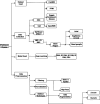A survey of detection of Parkinson's disease using artificial intelligence models with multiple modalities and various data preprocessing techniques
- PMID: 39703622
- PMCID: PMC11657906
- DOI: 10.4103/jehp.jehp_1777_23
A survey of detection of Parkinson's disease using artificial intelligence models with multiple modalities and various data preprocessing techniques
Abstract
Parkinson's disease (PD) is a neurodegenerative brain disorder that causes symptoms such as tremors, sleeplessness, behavioral problems, sensory abnormalities, and impaired mobility, according to the World Health Organization (WHO). Artificial intelligence, machine learning (ML), and deep learning (DL) have been used in recent studies (2015-2023) to improve PD diagnosis by categorizing patients and healthy controls based on similar clinical presentations. This study investigates several datasets, modalities, and data preprocessing techniques from the collected data. Issues are also addressed, with suggestions for future PD research involving subgrouping and connection analysis using magnetic resonance imaging (MRI), dopamine transporter scan (DaTscan), and single-photon emission computed tomography (SPECT) data. We have used different models like Convolutional Neural Network (CNN) and Gated Recurrent Unit (GRU) for detecting PD at an early stage. We have used the Parkinson's Progression Markers Initiative (PPMI) dataset 3D brain images and archived the 86.67%, 94.02%, accuracy of models, respectively.
Keywords: Artificial intelligence; Gait; MRI; PET; Parkinson’s Disease; data preprocessing.
Copyright: © 2024 Journal of Education and Health Promotion.
Conflict of interest statement
There are no conflicts of interest.
Figures





Similar articles
-
A Computerized Analysis with Machine Learning Techniques for the Diagnosis of Parkinson's Disease: Past Studies and Future Perspectives.Diagnostics (Basel). 2022 Nov 5;12(11):2708. doi: 10.3390/diagnostics12112708. Diagnostics (Basel). 2022. PMID: 36359550 Free PMC article. Review.
-
Exploring the Potential Imaging Biomarkers for Parkinson's Disease Using Machine Learning Approach.Bioengineering (Basel). 2024 Dec 27;12(1):11. doi: 10.3390/bioengineering12010011. Bioengineering (Basel). 2024. PMID: 39851285 Free PMC article.
-
A review of machine learning and deep learning for Parkinson's disease detection.Discov Artif Intell. 2025;5(1):24. doi: 10.1007/s44163-025-00241-9. Epub 2025 Mar 12. Discov Artif Intell. 2025. PMID: 40092968 Free PMC article. Review.
-
An Ensemble of CNN Models for Parkinson's Disease Detection Using DaTscan Images.Diagnostics (Basel). 2022 May 8;12(5):1173. doi: 10.3390/diagnostics12051173. Diagnostics (Basel). 2022. PMID: 35626328 Free PMC article.
-
Dynamic properties in functional connectivity changes and striatal dopamine deficiency in Parkinson's disease.Hum Brain Mapp. 2024 Jul 15;45(10):e26776. doi: 10.1002/hbm.26776. Hum Brain Mapp. 2024. PMID: 38958131 Free PMC article.
References
-
- Spears C. Dopamine agonists retrieved. 2018. Available from: http://www.parkinson.org/understanding/parkinsons/treatment/prescription... .
-
- Armstrong MJ Okun MS. Diagnosis and treatment of Parkinson disease: A review. JAMA. 2020;323:548–60. - PubMed
-
- Valls-Solé, Josep. and Francesc Valldeoriola. “Neurophysiological correlate of clinical signs in Parkinson’s disease.”. Clinical neurophysiology. 113(6):2002, 792–805. - PubMed
-
- Brooks DJ. Imaging approaches to Parkinson disease. J Nucl Med. 2010;51:596–609. - PubMed
Publication types
LinkOut - more resources
Full Text Sources

